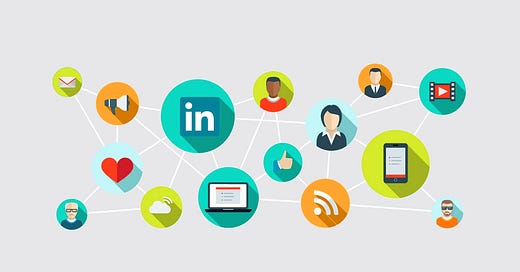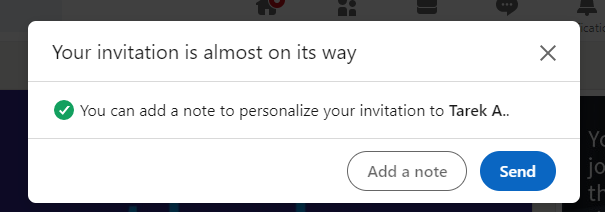Imagine if someone came up to your front door, rang the bell, and just stood there without introducing themselves.
“Uh, may I help you?”
No response, just silence. You shut the door and look out the window hoping the person leaves before you have to call the cops.
Then some time later, a woman knocks on the door. She is wearing a big grin and reaching out with an outstretched arm.
“Hi, we have many of the same friends. Let’s also be friends.”
“Ok, but do we know each other or have met before?”
Nothing registers, so once again you shut the door and wait to see if this person leaves your house.
Now a third person rings the doorbell, and he is ready to shake your hand.
This is getting weird you think, but just to humor the guy, you shake his hand.
“Thank you for accepting my offer! I run a marketing agency and I would love to schedule 15 minutes of your time to discuss how we can create 3x more pipeline!”
You shut the door in his face and wonder if this is some prank show you are on…
We can all relate. Not to getting interrupted by strangers coming to our front door, but this thing we use called LinkedIn. In the past, it seems that it has become a tool that is more spammy than ever before.
I have always been a believer in LinkedIn. I started using LinkedIn the year after it launched. While the public resume concept was interesting, what was more intriguing was the ability to connect with other business professionals around the globe, but all online without ever meeting in person.
This became more important when I launched my own HR technology startup. I had zero network outside of the few companies I sold to while at previous employers. By using LinkedIn however, I could network with HR thought leaders, prospect corporate HR leaders in enterprises, and connect with investors to fund my startup.
When I became a full-time angel investor, I further expanded my network, connecting with entrepreneurs, investors, and startup ecosystem influencers. It helped drive deal flow, expanded my influence, and led to many great business relationships along the way.
The past several years, much of my time has been spent expanding the Enterprise Sales Forum into a global B2B sales community. As we launched in cities from London to Toronto to Singapore and beyond, LinkedIn has been an enormously helpful in extending my reach and allowing me to share our sales community with B2B sales professionals like yourselves.
I later used many of same strategies and tactics to build my network of CTO’s and engineering leaders while at Stack Overflow. I built trust, credibility, and rapport with decision makers, which helped to build pipeline and grow sales of our new Enterprise offering.
My secret though is not about playing the volume game. Anyone can do that and there are many automation tools you can use to quickly build up thousands of connections. It also has nothing to do with the length of time that I have been on LinkedIn. The secret is that I connect with people using an authentic, personalized approach.
TAKING THE PERSONAL ROAD
Does a personalized approach really matter? If I turn that question around, how many unsolicited sales & marketing emails do you receive in a week? We put LinkedIn in a different category though because it is a “business platform” and as salespeople, we often do not care so much about unsolicited connections.
As with email however, we are reaching a saturation point in social networks where there is too much noise to respond. So our default coping mechanism is to ignore, delete, and forget. LinkedIn is squarely the culprit in this current state of affairs, which even led me to take the drastic action of rebuilding my LinkedIn account.
Consider the fact that very few people are responding to InMails. I myself have plenty of credits but rarely use them, and I have not responded to an InMail in years. People long ago realized InMail was a swamp pit of spammy outreach and slimy sales pitches.
Because InMails have become increasingly ineffective, most of that messaging activity has moved to direct Connection Requests. This is where the trouble begins.
In the past, users had to indicate how they knew someone and there was a text box to add a few sentences for context. Now we are presented with two choices; the easy way and the less easy way. Guess which way 99% of people chose? Even with the friendly advice to include a personal note, everyone just hits that Big Blue Button.
I regularly will have over 100 invites in my connection queue. Some people would just accept them all and be done. However, I do not subscribe to the open networker philosophy. These are people that have “LION” in their LinkedIn tagline, or simply just connect with everyone.
Why not connect with everyone? One is the practical consideration that it is hard to manage a large network. There is also the fact that LinkedIn has a 30K limit on number of connections. But more importantly is that I genuinely want to know the people I am connecting with. While I cannot invest the time that I used to in learning about each person, a short note when connecting helps.
When people reach out to connect and do not leave a personal note, what do I do? I send a short but welcoming response to ask them to share more about themselves and what they are working on. Here’s an example:
Hi Sarah, Glad to connect. Would be great to know a bit more about you and what you are working on. Thanks for reaching out! -Mark
For those people I feel could be legitimate connections, I get about a 20% response rate. But for those that do not respond, I wonder what is the point of connecting then if they do not engage? How is that networking and building relationships?
THE AUTHENTIC WAY TO CONNECT
For how I use LinkedIn, it has been my unfair advantage. Most people put in minimal effort and are lazy networkers. The way I standout and demonstrate value is to connect with purpose. That means taking a genuine & authentic interest in people and making a clear case as to why connecting is worthwhile from their perspective.
This stars by sending a short, concise, and personal note to the person you want to connect with. Be warned though, these are common examples that DO NOT WORK, but that I often see :
We have X number of common connections, let’s connect.
Your profile is interesting, let’s connect.
I’m in sales too, let’s connect.
We went to the same school, let’s connect.
I read your recent post, let’s connect.
Each of these messages suffers from a lack of context, a lack of a compelling reason, and a lack of empathy. They are no different than clicking the Big Blue Button. Do not ever use the above examples, it is bad form and borders on spam.
How then can you be genuine, authentic, and caring? You make the invite about the person you are connecting with and having a specific ask. Here is an example:
Hello Mark,
I enjoyed your post “Why Salespeople Are Better Than Marketers”. I also think marketers are terrible. I am a newbie entrepreneur struggling with sales and saw you host great sales talks. Would love to connect and ask a few questions about startup sales.
Thanks, Lucy
If you want to think of the example as a template, the structure takes the following format:
Hello [FIRST_NAME],
[INTERESTING THING ABOUT THEM]. [MY REACTION TO INTERESTING THING]. [WHO I AM]. [WHY I AM REACHING OUT]. [NEXT STEP].
Thanks, [MY NAME]
Why would this stand out? Because they made it about the recipient, they made it personable, and they had an ask. It is also concise and to the point, which the 300 character limit of the message box enforces. This forces you to think carefully about how to structure your invite to be creative and efficient for most impact.
Even in cases where you have met or interacted with the person, my default is to send a personalized request. Why? Because people can forget. In settings where it is busy like a conference or it’s been long period of time between meeting and connecting on LinkedIn, a short reminder helps.
For example, you can do something similar to the following example:
Hi Mark, It was great to meet you at the AWS User Group last week in Singapore. I thought the talk on MVP’s was super insightful. I would love to connect and stay in touch. Cheers, Simon
It does not have to be lengthy. The point is that it provides context, it’s complimentary to the recipient (some amount of ego-stroking helps), and it’s a simple and memorable note.
In the meantime, here are two helpful and practical LinkedIn tips to get you going on managing your connections.
TIP #1
If you are trying to send personalized invite using LinkedIn’s mobile app, it can be tricky. First, I would recommend you not use the mobile app when sending connection requests. It is better to sit down and take time to craft something meaningful. You can always “save” interesting profiles while you are on the go as I explain below
Second, if you really must send that invite right now and all you have is your phone, you can in fact do that on the mobile app. Go to the profile of the person you wish to connect to, click on the More button right next to the Big Blue Connect button, select “Personalize invite”, type your message, and click Send in the top right of the screen. Note that in the More options, you can Follow the person or Share profile via and use one of your mobile apps to save a note to the profile or send yourself an email.
TIP #2
So if someone sends you a non-personalized invite, how do you send a response to that person? On the mobile app, this is impossible, but you can on the website. Go to My Network in the top menu bar. In the Invitations box, there is some text to the top right that says Manage. Click that and below each invite, there is a link called Messages or Reply to [NAME]. Click that and you can send a Message.
My goal is to help you step up your social networking efforts and become masters of LinkedIn to build a solid professional network. The benefits are truly amazing when you take the time to care about others and take a genuine interest in them. Do not aim for quantity of connections, always aim for quality of connections. With quality there is trust and with trust comes opportunity.
Take care and happy connecting!
Mark Birch, Founder of the Enterprise Sales Forum
If you found this essay personally helpful, I encourage you to sign up for the weekly Enterprise Sales Forum Newsletter where I share my thoughts on the state of B2B sales, practical tips for improving your sales acumen, and upcoming sales talks across the global Enterprise Sales Forum community.







In the conference/meetup setting it best to connect on the spot using the LinkedIn app's QR code feature.